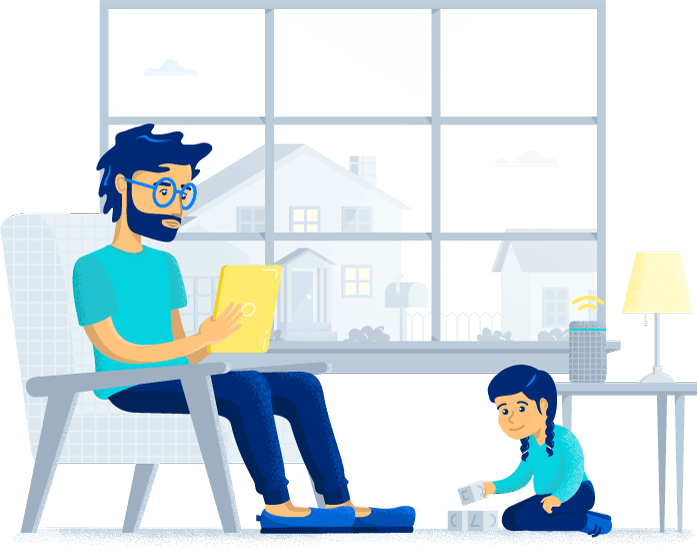As the 2020 pandemic showed us, there are few issues as pressing today as the digital divide — especially for students who have had to adapt to remote learning in the past year.
According to a June 2020 report from Common Sense Media and the Boston Consulting Group, more than 50 million public school students were learning from home during the pandemic, but a staggering nine million didn’t have the necessary device or internet connection.
This gap usually falls along racial and economic lines. According to a Pew Research Center study, Black and Hispanic people were around 25% less likely to own a laptop or desktop than white people and 13% and 18% less likely to have a home broadband subscription, respectively.
Fortunately, there are several nonprofits currently working to address the issue. We vetted each of these organizations using ProPublica’s Nonprofit Explorer tool to ensure they use donations responsibly.
Organizations addressing internet access
The primary barrier for many people connecting to the internet is a lack of affordable or high-speed options in their area. These organizations are working to get more people connected with quality home broadband services.
EveryoneOn
One of the few digital divide nonprofits that addresses internet service itself, EveryoneOn helps connect low-income families with affordable internet plans and devices in their area. Its flagship program, Connect2Compete, partners with national broadband providers to offer reduced internet plans for qualifying families. It also has a number of free digital literacy training programs for adults looking to improve their skills.
human-I-T
One of the more well-known nonprofits working to address the digital divide, human-I-T aims to provide people with the equipment and internet access they need to thrive in a digital world. In addition to refurbishing and distributing donated equipment, human-I-T also helps people get connected to affordable internet options in their area. You just fill out a form with your information, and one of their volunteers will contact you to discuss your best options.
Mobile Citizen
While not a nonprofit itself, Mobile Citizen provides low-cost wireless internet to nonprofit organizations, educational entities and social welfare agencies. The service operates nationwide on the Sprint network, and plans range from entirely free to $10/mo. for qualifying organizations. All plans come with unlimited data.
National Digital Inclusion Alliance
The National Digital Inclusion Alliance (NDIA) is one of the largest organizations addressing the digital divide in the U.S. It brings together hundreds of community advocates around the country who are working to expand broadband access. The NDIA works in every area of the issue, from connecting consumers to low-cost plans available to them to lobbying for federal funding. If you’re looking for a place to get started, the NDIA acts as a sort of headquarters for nonprofits addressing the digital divide.
Partners Bridging the Digital Divide
If you’re looking for an all-in-one resource for organizations promoting equitable internet access, Partners Bridging the Digital Divide provides a useful directory of these nonprofits. They are also an excellent source for learning more about strategies to bridge the digital divide, with regular newsletters an experience papers that consolidate learnings from across their 36 partner organizations.
Schools, Health and Libraries Broadband Coalition
The Schools, Health and Libraries Broadband (SHLB) Coalition is pretty much exactly what it sounds like: It advocates for better broadband connections in anchor institutions and their communities. The SHLB Coalition primarily accomplishes its goals by lobbying Congress to properly fund these community anchors.
Organizations that refurbish devices
There are a number of nonprofit organizations that are helping to close the digital divide by recycling and refurbishing computers and devices. Most of them accept donations in the form of cash or devices themselves.
Close the Gap
Close the Gap is an international nonprofit organization that provides refurbished computers to schools and social agencies in developing countries. They coordinate every step of the process, from collecting donations to refurbishing the old technology to installing and maintaining the computers in their new homes. Since 2003, Close the Gap has distributed more than a million computers from companies around the world.
Computers for Kids
As a registered Microsoft refurbisher, Computers for Kids specializes in taking old computers, fixing them up like new and donating them to schools, nonprofits and students in grades K-14. Since 2002, the organization has distributed over 50,000 refurbished Microsoft computers in Idaho, Washington and Oregon.
Devices for Students
Created in response to the COVID-19 pandemic’s impact on our education system, Devices for Students aims to provide children all the tools they need to learn remotely. The organization purchases laptops and data hotspots and takes donations, then configures them with the necessary software for online learning and distributes them to students in need.
Notebooks for Students
Started in 1998 by a group of college students who struggled to find laptops for their classwork, Notebooks for Students sells discounted computer equipment to students. All of the nonprofit’s laptops are certified by technicians and include a four-year warranty. In most cases, they are significantly discounted from the retail price.
Two Screens for Teachers
The name says it all. Two Screens for Teachers was created to address a very specific problem that’s come up during the COVID-19 pandemic: Teachers often only have one computer and can’t see their students and their lesson plans at the same time. The nonprofit uses cash donations to buy extra monitors and distributes them for free to teachers who request them.
Regional organizations
In addition to the nonprofits above who are addressing the digital divide from a national level, there are a number of regional organizations working on the issue, too.
Byte Back: Washington D.C. and Baltimore, MD
This D.C.-based nonprofit focuses on providing free classes to students to prepare them for careers in tech. Once students graduate from one of Byte Back’s professional tracks, the organization connects them with local companies that are hiring. It also offers free “Computer Foundations” courses for adults who are new to computers or looking to update their skills.
Computers for Classrooms: California
One of the oldest digital divide nonprofits around, Computers for Classrooms has been connecting students and low-income earners with technology since 1991. The nonprofit receives donations and sells them to schools and eligible individuals at a reduced price. Laptops currently start at $150 on their website.
Computing for All: Seattle, WA
Computing for All says its mission is to help people who are “under-represented in the IT industry and lacking in opportunities.” It offers training, mentoring and hands-on work in several different career tracks to high school juniors and seniors. Computing for All also partners with local businesses to give students first-hand experience in the industry.
Government programs
Computers for Learning
The Computers for Learning program was created as a part of an Executive Order signed by President Clinton in 1996, and it’s still going strong today. It allows federal agencies to donate their excess computers and technology, where eligible recipients can then view and request specific equipment. The program is open to K-12 schools and educational nonprofits.
Lifeline
Lifeline is a permanent program that provides $9.25/mo. to low-income households for their cellphone or internet bills. Like the Emergency Broadband Benefit, you’ll need to qualify for a federal program like SNAP or Medicaid to take advantage of Lifeline.
Allconnect: Let us compare providers for you
Why should you choose Allconnect? We’re the #1 broadband marketplace in the U.S, meaning you can trust us to search, compare and order internet and TV service for your home.
Get started

Written by:
Joe SupanPrincipal Writer, Broadband Content
Joe is a senior writer for CNET covering home technology and broadband. Prior to joining CNET, Joe led MYMOVE’s moving coverage and reported on broadband policy, the digital divide, and privacy issues for the br…
Read more
Edited by:
Robin LaytonEditor, Broadband Content
-
Featured
![Learning loss and the digital divide: Summer resources for all students]() Learning loss and the digital divide: Summer resources for all students Ari Howard — 4 min read
Learning loss and the digital divide: Summer resources for all students Ari Howard — 4 min read -
Featured
![A community guide to advocating for better broadband services]() A community guide to advocating for better broadband services Ari Howard — 7 min read
A community guide to advocating for better broadband services Ari Howard — 7 min read -
Featured
![How to get free and discounted internet]() How to get free and discounted internet Joe Supan — 4 min read
How to get free and discounted internet Joe Supan — 4 min read
Latest
-
Thursday, July 25, 2024
Worried about losing your signal? This is how to keep your satellite dish cleanDavid Anders — 6 min read
-
Tuesday, July 23, 2024
The best free TV and movie streaming services 2024Camryn Smith — 5 min read
-
Tuesday, July 23, 2024
Everything you need to know about internet speedsRobin Layton — 8 min read






